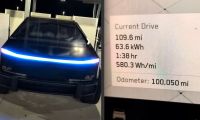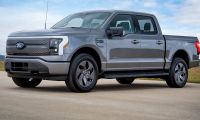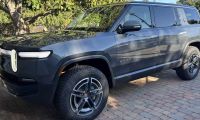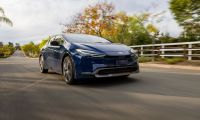Tesla's American market deliveries in the first half of 2019 were only about half that of its deliveries in the second half of 2018. There are a variety of reasons why Tesla's U.S. sales have declined by such a sharp rate. But first, why this timeline matters.
Tesla Model 3 Delays & Production Problems
Tesla's Model 3 launch was a fiasco. The Model 3 was very late to market, and production SNAFUS (just like the ones that plagued the Model X when it was launched) held the Model 3's launch plan back by about six months. By the middle of last year, the production problems had been sorted and Tesla was able to make as many Model 3 sedans as it could deliver. Thus, we can compare the past two half-years of deliveries in the U.S. since the factories were operating properly.
Tesla Delivery Scorecard Second Half of 2018
In the second half of 2018, Tesla delivered 115,950 Model 3 premium/performance sedans to North American customers. Feel free to include Canada or not, it doesn't change anything in the delivery volume in any meaningful way. We will base our delivery information on facts provided by Inside EVs. In addition, Tesla delivered 16,575 Model X luxury/performance minivan/crossovers and 14,925 Model S luxury/performance sedans. Since that half-year period, every one of Tesla's vehicle's has dropped dramatically in sales in the U.S.
Tesla Delivery Scorecard 2019 YTD
In the first half of this year, Tesla has delivered only 67,650 Model 3 cars in the U.S. Down by almost half. Tesla also has seen a drop off in the Model X and Model S. Tesla delivered 9,000 Model X vehicles and 7,225 Model S cars. Tesla delivered less than half the number of its Model S cars in 2019's first half compared to the second half of '18.
Tesla Overseas Sales
Once Tesla's backlog of pre-orders dried up, Tesla wisely shifted its delivery allotment to overseas markets. Rather than continue to ship all of its zero-emission vehicles in its home market, Tesla opted to load them onto fossil-fuel guzzling, carbon-spewing cargo ships and send them to other markets where demand and prices are higher. This helps to keep the lagging demand in the U.S. a bit tighter.
Still, Tesla was offering discounts on new, never driven Tesla cars in Q2, Something Elon Musk vowed never to do. The company also put on quite a sales push in Q2 to ensure that it sold and delivered as many cars as possible.
What's next for Tesla?
Tesla's domestic demand has stabilized for the Model 3. Most buyers who were waiting for one now have had a chance to buy one from inventory. Tesla has now bailed on the idea of a $35K Model 3 and instead has opted to sell the Model 3 in the premium price ranges of averaging about $50K. That is our estimate based on monitoring sales informally.
We have asked Tesla what its average transaction price is for the Model 3 and also asked how many SR+ cars it has delivered, but Tesla won't answer such inquiries. The company prefers to give the impression that the Model 3 is priced lower than it actually is.
It is hard to predict how many vehicles Tesla will deliver to U.S. customers in the second half of 2019. By all accounts, it seems that demand has now stabilized for the X and S below the prior highs for those models. How much Model 3 inventory will be allocated to the U.S. is also not predictable. However, we can make one prediction with pretty high confidence.
Tesla's best half-year of U.S. sales is now behind it, at least for the foreseeable future. With Tesla's prices having just risen substantially due to the change in the federal tax deduction, the folks looking for Tesla price deals bought in Q2. At least the smart ones.
Below you can watch the video released by Euro NCAP on Model 3 safety and please also click here to subscribe to Torque News Youtube channel for daily Tesla and Automotive news analysis.
John Goreham tweets at @johngoreham. Please send him news tips and follow us at @TorqueNewsAuto.













Comments
I always find it amusing how
Permalink
I always find it amusing how you can turn around Tesla's success into a perceived failure. Nobody expected Tesla to top their record volume sales of last year when their was a huge standing waiting list for cars, and the federal tax credits were at peak. Elon Musk actually set relatively modest (for him) goals of Model 3 sales this quarter, and it was a big surprise that they actually built and delivered far more Model 3s than their set target goals in the 2nd quarter. With deliveries starting in Europe and China, those numbers will grow even more moving forward. But you can keep reading their success as a forecast of doom if you like.
If I were going to pen just a
Permalink
In reply to I always find it amusing how by DeanMcManis (not verified)
If I were going to pen just a single Tesla story this quarter, the story would be different. But this is just one of the many green vehicle stories I wrote this week. If you see this story as portraying Tesla as a failure, I see that as your viewpoint. I lay out the delivery facts, add perspective (factual) and I even call Tesla's shift of inventory "Wise." There are many publications and writers who simply pander to Tesla and Tesla fans. There are few that look deeper and provide a picture for the reader to interpret.
Really John, are you trying
Permalink
Really John, are you trying to portray yourself as someone who relays the facts about Tesla in an unbiased way? I cannot recall ANY article that you have written about Tesla which shows an unbiased view, and doesn't go out of it's way to show Tesla as failing, losing value, and building a flawed product. You may not be personally gaining from Tesla's losses, but wherever you get your biased information and source articles are certainly short selling Tesla stock for profit. Saying that you are a counterpoint against publications that pander to Tesla doesn't really ring true because there are not attention getting headline articles here that similarly, blindly promote Tesla without any mention of the other side. And your articles do not ever reference those positive Tesla articles or link to them when expressing the opposite viewpoint.
My primary source for this
Permalink
In reply to Really John, are you trying by DeanMcManis (not verified)
My primary source for this story (the U.S. sales data) was Inside EVs. I provided a link in the third para (higher links are more likely to be clicked). The sales tell their own story. Directly next to the story if you view it on a computer (not sure about mobile) there are a list of "Related Stories." Here are the ones listed from the top: 1) "Tesla Outsold Acura, Volvo, Jaguar, Land Rover, Porsche in First Half of 2019 in U.S." 2) 3 Features That Earned Tesla Model 3 Top Safety Ratings 3) Tesla Semi Truck Quietly Rolls Into A SuperCharger Center 4) New Report Highlights Tesla Model 3 and Honda Clarity PHEV for Increased EV Adoption. There are 15 in total, including "5 Exciting Events Still Happening in 2019 At Tesla." This story is factual. I could care less about the stock shorting issue. I don't own any individual stocks. Though Tesla's stock price is sometimes a valid topic. I'd be surprised if Inside EVs is part of a stock short conspiracy against Tesla. It seems to be a respectable publication that is a strong advocate for Tesla. I do appreciate your feedback. You are a true EV advocate, and I realize not every story brings a smile. I can write that way, but I like to cover all sides. Not just the sunny side.
"With Tesla's prices having
Permalink
"With Tesla's prices having just risen substantially due to the change in the federal tax deduction, the folks looking for Tesla price deals bought in Q2. At least the smart ones."
The federal tax deduction was lowered by $1875. That's hardly substantial!
Tesla even lowered the price of their cars by a few grand to make up for it.
People buying Teslas today get the new active suspension and more efficient motors which increased the range by more than 10%.
Good points Rusell. Thanks
Permalink
In reply to "With Tesla's prices having by Russell (not verified)
Good points Rusell. Thanks for adding that info.
And yet you couldn't get that
Permalink
In reply to Good points Rusell. Thanks by John Goreham
And yet you couldn't get that "good point" into your article?
So much for your integrity.
In fairness, the statement
Permalink
In reply to And yet you couldn't get that by Mark Schaffer (not verified)
In fairness, the statement made in the story included a link to a very detailed story on the matter. So, in a sense, it is in the story. And I think it is debatable whether $1,875 is a significant amount of money.
By definition it isn't in the
Permalink
In reply to In fairness, the statement by John Goreham
By definition it isn't in the story. Nice try.
The real point is that for
Permalink
The real point is that for your critical analysis to be taken seriously you need to compare the seasonal changes in Tesla’s figures to those of other car companies. Everyone remotely connected with the car industry knows that the first quarter is ALWAYS significantly down on the previous quarter- but when it happens to Tesla, it’s the end of the company. Please list the 2nd half figure of last year for ALL manufacturers against the 1st half of this year, and describe all the sales incentives - then we might start to take you seriously.
Normally, I would agree with
Permalink
In reply to The real point is that for by Alan Duxbury (not verified)
Normally, I would agree with you 110%. Seasonality is important with regard to deliveries and sales. However, Tesla's production is the really significant factor now, not seasonality. The story mentions that Tesla's production capacity came to full capacity in the past two half-years (past year). So, looking back to Tesla's prior half-year periods is really no indicator of its abilities. Seasonality is a big factor in month to month sales for most automakers, and in particular, luxury makers. With Tesla, the seasonality is really insignificant at this point.
Surely it is well known that
Permalink
In reply to Normally, I would agree with by John Goreham
Surely it is well known that the large manufacturers keep up their manufacturing figures by pushing completed product to the dealers, who then, in order to make space sell them at perpetually changing heavy discounts - often subsidized by the manufacturers! One would think that when you can purchase a car with a 9 or 10 thousand dollar "savings" that consumers would realize that they are being ripped off the rest of the time when those putative savings are not available. As Tesla does not have a network of dealers, all willing to sell at any cost so that they can get the future service work (of which there is little with a Tesla) then it is clear to me that Tesla are keeping a very tight hand on their production quantities and expanding mainly to keep up with the steady growth of orders. To me this seems like an exceedingly intelligent way of steadily growing the company. As I write this response, a "Related to this story" box also says "Tesla Outsold Acura, Volvo, Jaguar, Land Rover, Porsche in First Half of 2019 in U.S." - so I think that they are doing just fine.
To limit the scope of the
Permalink
To limit the scope of the article to North America is to utterly ignore what is happening as other markets are being opened. As Tesla has noted orders exceeded production at the end of the quarter.
I guess that would be true
Permalink
In reply to To limit the scope of the by Mark Schaffer (not verified)
I guess that would be true (ignoring what is happening in other markets), but there is a paragraph, headlined in bold print that points out Tesla shifted its inventory allocation in this period "to overseas markets." And that para also mentions the relationship to orders vs production (demand).
Then you should have counted
Permalink
Then you should have counted total numbers as well.